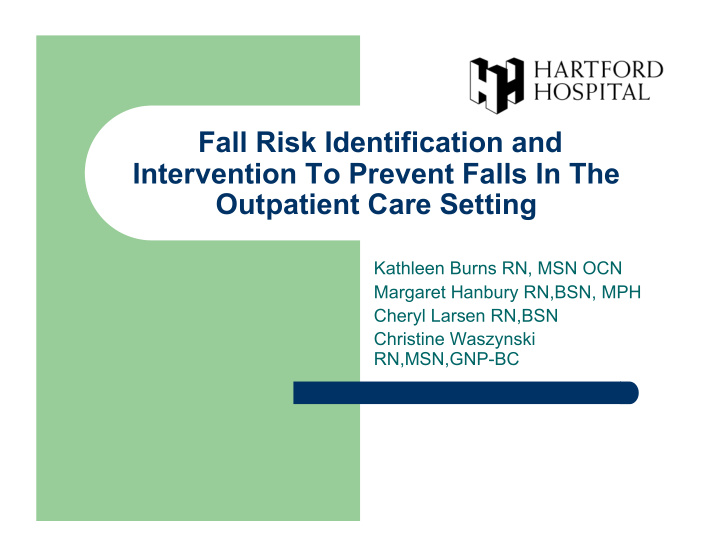



Fall Risk Identification and Intervention To Prevent Falls In The Outpatient Care Setting Kathleen Burns RN, MSN OCN Margaret Hanbury RN,BSN, MPH Cheryl Larsen RN,BSN Christine Waszynski RN,MSN,GNP-BC
Issue Fall prevention is an important safety issue for health care systems Hospital initiatives many times begin with initial focus on the inpatient population
Misperception Historically, the perception of patients using outpatient services and outpatient surgery was that they were “healthier” Falls were not perceived to be a significant issue in this population
The Truth Our hospital reported 143 falls, 40 injurious, from January 2007 to May 2010 occurring in outpatient dialysis, psychiatry, radiology, oncology, gastroenterology, cardiology, wound care, phlebotomy, day surgery and rehabilitation.
Root Cause Analysis Weakness Dizziness During exercise in rehab setting Environmental ( parking lot/ entry way)
Out Patient Falls 1/07-4/10
Induced Risk Factors For Falls Majority of procedural outpatient population received moderate sedation or anesthesia, increasing risk of falls Rehab patients have inherent risk based upon their physical needs Oncology patients receive therapies that cause weakness, nausea, anemia The risk of fall may be transient (due to our procedures) or pre-existing (due to risks patient has at baseline)
Fall Risk Assessment Staff focused on the issue “at the top of the problem list” and immediate needs Few triggers on outpatient assessment tool to address fall risk Fall risk factors are not prominent May not prompt the nurse to think of a fall potential (vision/ hearing impairment, mobility limitations) *
Research Question Will the implementation of a fall risk screening tool and protocol decrease patient falls in outpatient areas?
Inpatient Fall Risk Protocol Fall Risk Screen to identify patients at risk for falls Green “Fall Risk” bracelets and green triangles on the door to identify patients at risk Fall risk patients highlighted on Manager Unit Report to assist in rounding Bed and chair alarms to deter unassisted ambulation Supervision during toileting
Issue Will the inpatient fall prevention protocol meet the needs of the outpatient population?
Operative and Other Procedures Workgroup Ambulatory Surgery GI/Endoscopy Interventional Radiology Radiation Oncology Ad hoc consultation: Rehabilitation sites, dialysis, outpt psych, wound care center
Analysis and Plan Recognized that fall risk assessment and interventions were inconsistent or non- existent in areas Workgroup recognized need to: Develop outpatient fall risk assessment Identify interventions that could be implemented in the outpatient areas Mirror inpatient process and interventions as much as possible
Challenges The outpatient population is a very diverse group Each outpatient area is very different from the other (rehab vs ambulatory surgery vs radiation oncology) Cheryl Larsen met one on one with each area to promote a basic protocol with individualization based upon specific patient populations
Revision Took inpatient tool and revised for use in outpatient procedural areas Fall History to ground Confusion/Disorientation Mobility impaired – transfers, leg weakness, assistive devices Elimination altered Other (inpatient nursing judgment, diagnosis- related) * highlight risks in each specific outpt setting
Adjustments for Assessment All areas involved to ensure that triggers for risks specific to their areas were included (i.e. volume depletion, hypotension; GI/Endoscopy; dialysis) Adjustments made to accommodate assessments for patients having daily or weekly treatments (i.e. Radiation Oncology; dialysis)
Adjustments for Interventions green bracelet and triangle patient and family education assist with all transfers, activity if needed assist with clothing, i.e. nurse or PCA must help with dressing or undressing of patient* Toileting assistance and supervision
Onsite Assessment of Cancer Center January 2010 Heavy doors Slippery floors Large open space without rails Treatment table-potential for rolling off Emergency call bell too soft Toilets too low
Outpatient Challenges Heterogeneous Patient Group – inpatient/outpatient – move around – lack of consistent EHR – difficult to identify fall risk – multi role staff
The story of Brian Independent, inpatient: no fall risk Medicated, radiation patient: big fall risk
Findings (graph)
Interpretation Each outpatient area is at a difference stage of implementing the fall prevention protocol Refinement still occurring in each area to meet the needs of their patient population Too short of an evaluation period to comment on the reduction of the total number of falls… however……….
Lessons Learned Fall prevention is now highlighted in the outpatient area Increased reporting of falls Staff are more aware of fall potential- ask for coverage for pt supervision when necessary
Future Plans Promote roll out of outpatient fall prevention protocol in all settings Continue to study falls with root cause analysis Learn from one another
Recommend
More recommend